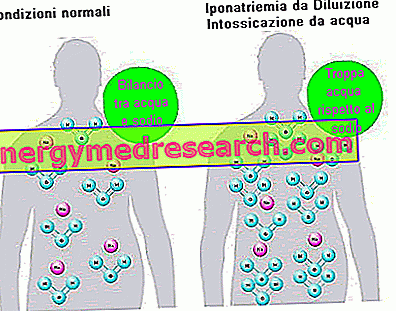Water intoxication can be differentiated into:
- CHRONIC water intoxication
- ACUTE water intoxication
It is always a body hyperhydration at the expense of extracellular sodium concentrations (dilution hyponatremia), which causes strong metabolic and homeostatic decompensation; however, CHRONIC water intoxication and ACUTE water intoxication differ from one another in ATIOLOGICAL CAUSES and ASSOCIATED CLINICAL FRAMEWORK.
CHRONIC water intoxication
CHRONIC water intoxication occurs mainly as a secondary complication of other metabolic disorders:
- Inappropriate secretion of antidiuretic hormone ( antidiuretic hormone - ADH), disorder also called secretion inappropriate antidiuretic hormone (SIADH). As can be easily understood, it is the hormonal hypersecretion of ADH that inexorably causes the excessive reduction (due to dilution) of extracellular sodium (hyponatremia) due to an exaggerated renal water reabsorption.
- Abuse of antidiuretic drugs (desmopressin, chlorpropamide, acetaminophen and indomethacin), which enhance the action of ADH and inhibit renal regulation.
- Glucocorticoid deficiency (steroid hormones produced by the adrenal gland).
- Chronic nephropathies, which cause a reduction in the glomerular filtrate, increasing body hydration and consequently diluting the sodium content.
- Mixedema, a typical condition of hypothyroidism; it determines an accumulation of hyperosmotic substances in the subcutaneous tissue which, by attracting water, favor the recall of interstitial fluids.
- Potassium depletion, also called hypokalemia or hypopotassemia.
The treatment of CHRONIC water intoxication can be carried out by eliminating or reducing the primary triggering factor.
ACUTE water intoxication
ACUTE water intoxication can occur in a short time; to determine the rapidity of onset are the importance and the typology of the etiological cause:
- Correction of acute hypovolemia ; this condition is caused by an acute pathological reduction in plasma volume that MUST be urgently countered by drug therapy. If the treatment is excessive or not well balanced in the joint supply of electrolytes, it is possible to obtain the opposite effect by overhydration with ACUTE water intoxication.
- Early post-operative.
- Unique administration of ADH-like drugs.
- Psychogenic polydipsia, state or SENSATION of intense thirst that induces the subject to ingest considerable quantities of liquids.
- Excessive dilution of the formulated milk, which causes the child to over-hydrate with a consequent increase in the dilution of body sodium.
- Error in the hydration of endurance athletes ; this condition occurs in the athlete but only after excessive sweating and lack of mineral salts (including Na). This condition determines a metabolic decompensation better known as CEREBRAL HYPONATRIEMIA.
In the case of copious and prolonged sweating, typical of marathon runners or cyclists who compete in the summer months, the concentrations of sodium in the blood are reduced due to mineral losses with sweat. The same condition can affect "improvised" sportsmen, in which the mechanisms of heat dispersion and control of mineral losses are certainly not optimized as in the case of professional sportsmen. In both cases, in addition to natriemia, the volume (plasma volume) also tends to decrease due to water losses. If in such circumstances rehydration occurs through sodium-poor waters, the lack of the mineral in the drink causes the plasma sodium to be further diluted (the water assumed expands the plasma volume so that, although equal in absolute terms, the sodium concentration per unit of blood decreases by dilution, see figure below). We will therefore have the typical symptoms of water intoxication.
For this reason, after and during a prolonged effort, rehydration must first be carried out gradually (avoiding drinking too much water in a short time), preferring isotonic drinks or average mineralized water.

Both the water CHRONIC intoxication and the acute water INTOSSICATION are rather rare pathological forms; however, both are often accompanied by other organic or psychogenic disorders; therefore, it is also desirable that the clinical manifestation occur more often in the hospital setting or, similarly, that the subject is subjected to frequent and systematic monitoring; in this case, the specialist intervention SHOULD be sufficient to avoid the aggravation of water intoxication.
Characteristic symptoms
Water intoxication gives rise to the relative symptomatology only when sodium levels are no longer sufficient to counteract the level of hydration; this means that the relative visible and admirable clinical signs disregard the differentiation between chronic disorder or acute disorder and are common to both pathological forms.
The most frequent symptoms are nausea and vomiting which, if not treated, can lead to coma. Water intoxication can also trigger decidedly relevant mental effects which, if promptly identified and related to hyperhydration and hyponatremia, favor early diagnosis and statistical reduction of the fatal course; water intoxication frequently causes confusional states, loss of orientation and hallucinations (see cerebral hyponatremia). In this case, if the specialist DOES NOT possess sufficient elements to promptly recognize water intoxication, the need for differential diagnosis from SCHIZOFRENIA (which is common to hallucinations and confusion) is frequent.
Rarer, but also recognizable at a blood level for cytolysis enzyme markers, is the breakdown of muscle cells, better called rhabdomyolysis.
Prevent and treat water intoxication
In order to prevent water intoxication it is essential to promptly buffer the secondary effects attributable to pathologies responsible also for systemic hyperhydration. Each case is in its own right, but following the principle of early diagnosis it is possible to minimize the risk of a serious or poor prognosis.
Studies carried out on water intoxication have shown that, by drinking up to 10-20 liters of water in a few hours, death may occur; therefore, in order to prevent any negative effects, it is strongly recommended NOT to exceed 1-1.5 liters of water / hour to avoid reducing plasma sodium concentrations below 110-120mmol / l ( < 90-105mmol / l identifies the first symptoms of GRAVE entities).
The only useful therapy for the treatment of water intoxication is the BREAKING OF HYDRATION associated with DIURETIC PHARMACOLOGICAL THERAPY with furosemide (loop diuretic).




